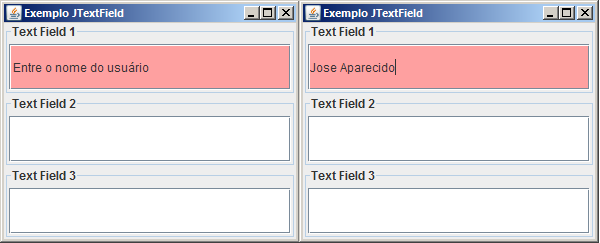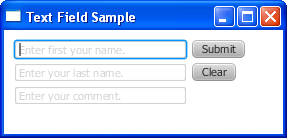De qualquer forma, eu vou dar um exemplo de uma classe (“TextPrompt”) que achei na Internet.
package guj;
import java.awt.Color;
import java.awt.event.FocusEvent;
import java.awt.event.FocusListener;
import javax.swing.JTextField;
import javax.swing.text.Document;
public class MeuJTextField extends JTextField {
public MeuJTextField() {
initialize();
}
public MeuJTextField(String text) {
super(text);
}
public MeuJTextField(int columns) {
super(columns);
}
public MeuJTextField(String text, int columns) {
super(text, columns);
}
public MeuJTextField(Document doc, String text, int columns) {
super(doc, text, columns);
}
private static final Color FOCUS_LOST_COLOR = new Color (255, 255, 255);
private static final Color FOCUS_GAINED_COLOR = new Color (254, 160, 160);
public void initialize() {
addFocusListener(new FocusListener() {
@Override
public void focusGained(FocusEvent e) {
setBackground(FOCUS_GAINED_COLOR);
}
@Override
public void focusLost(FocusEvent e) {
setBackground(FOCUS_LOST_COLOR);
}
});
}
}
package guj;
import java.awt.BorderLayout;
import javax.swing.BorderFactory;
import javax.swing.BoxLayout;
import javax.swing.JFrame;
import javax.swing.JPanel;
import javax.swing.JTextField;
import javax.swing.SwingUtilities;
public class TesteJTextField extends JFrame {
private static final long serialVersionUID = 1L;
private JPanel jContentPane = null;
private JPanel pnlTextField1 = null;
private JPanel pnlTextField2 = null;
private JPanel pnlTextField3 = null;
private JTextField txtField1 = null;
private JTextField txtField2 = null;
private JTextField txtField3 = null;
/**
* This method initializes pnlTextField1
*
* @return javax.swing.JPanel
*/
private JPanel getPnlTextField1() {
if (pnlTextField1 == null) {
pnlTextField1 = new JPanel();
pnlTextField1.setLayout(new BorderLayout());
pnlTextField1.setBorder(BorderFactory.createTitledBorder("Text Field 1"));
pnlTextField1.add(getTxtField1(), BorderLayout.CENTER);
}
return pnlTextField1;
}
/**
* This method initializes pnlTextField2
*
* @return javax.swing.JPanel
*/
private JPanel getPnlTextField2() {
if (pnlTextField2 == null) {
pnlTextField2 = new JPanel();
pnlTextField2.setLayout(new BorderLayout());
pnlTextField2.add(getTxtField2(), BorderLayout.CENTER);
pnlTextField2.setBorder(BorderFactory.createTitledBorder("Text Field 2"));
}
return pnlTextField2;
}
/**
* This method initializes pnlTextField3
*
* @return javax.swing.JPanel
*/
private JPanel getPnlTextField3() {
if (pnlTextField3 == null) {
pnlTextField3 = new JPanel();
pnlTextField3.setLayout(new BorderLayout());
pnlTextField3.add(getTxtField3(), BorderLayout.CENTER);
pnlTextField3.setBorder(BorderFactory.createTitledBorder("Text Field 3"));
}
return pnlTextField3;
}
/**
* This method initializes txtField1
*
* @return javax.swing.JTextField
*/
private JTextField getTxtField1() {
if (txtField1 == null) {
txtField1 = new MeuJTextField();
TextPrompt tp1 = new TextPrompt("Entre o nome do usuário", txtField1);
}
return txtField1;
}
/**
* This method initializes txtField2
*
* @return javax.swing.JTextField
*/
private JTextField getTxtField2() {
if (txtField2 == null) {
txtField2 = new MeuJTextField();
}
return txtField2;
}
/**
* This method initializes txtField3
*
* @return javax.swing.JTextField
*/
private JTextField getTxtField3() {
if (txtField3 == null) {
txtField3 = new MeuJTextField();
}
return txtField3;
}
/**
* @param args
*/
public static void main(String[] args) {
// TODO Auto-generated method stub
SwingUtilities.invokeLater(new Runnable() {
public void run() {
TesteJTextField thisClass = new TesteJTextField();
thisClass.setDefaultCloseOperation(JFrame.EXIT_ON_CLOSE);
thisClass.setVisible(true);
}
});
}
/**
* This is the default constructor
*/
public TesteJTextField() {
super();
initialize();
}
/**
* This method initializes this
*
* @return void
*/
private void initialize() {
this.setSize(300, 243);
this.setContentPane(getJContentPane());
this.setTitle("Exemplo JTextField");
}
/**
* This method initializes jContentPane
*
* @return javax.swing.JPanel
*/
private JPanel getJContentPane() {
if (jContentPane == null) {
jContentPane = new JPanel();
jContentPane.setLayout(new BoxLayout(getJContentPane(), BoxLayout.Y_AXIS));
jContentPane.add(getPnlTextField1(), null);
jContentPane.add(getPnlTextField2(), null);
jContentPane.add(getPnlTextField3(), null);
}
return jContentPane;
}
}
package guj;
import java.awt.*;
import java.awt.event.*;
import javax.swing.*;
import javax.swing.border.*;
import javax.swing.event.*;
import javax.swing.text.*;
/**
* The TextPrompt class will display a prompt over top of a text component when the Document of the text field is empty.
* The Show property is used to determine the visibility of the prompt.
*
* The Font and foreground Color of the prompt will default to those properties of the parent text component. You are
* free to change the properties after class construction.
*/
public class TextPrompt extends JLabel implements FocusListener, DocumentListener {
public enum Show {
ALWAYS, FOCUS_GAINED, FOCUS_LOST;
}
private JTextComponent component;
private Document document;
private Show show;
private boolean showPromptOnce;
private int focusLost;
public TextPrompt(String text, JTextComponent component) {
this(text, component, Show.ALWAYS);
}
public TextPrompt(String text, JTextComponent component, Show show) {
this.component = component;
setShow(show);
document = component.getDocument();
setText(text);
setFont(component.getFont());
setForeground(component.getForeground());
setBorder(new EmptyBorder(component.getInsets()));
setHorizontalAlignment(JLabel.LEADING);
component.addFocusListener(this);
document.addDocumentListener(this);
component.setLayout(new BorderLayout());
component.add(this);
checkForPrompt();
}
/**
* Convenience method to change the alpha value of the current foreground Color to the specifice value.
*
* @param alpha value in the range of 0 - 1.0.
*/
public void changeAlpha(float alpha) {
changeAlpha((int) (alpha * 255));
}
/**
* Convenience method to change the alpha value of the current foreground Color to the specifice value.
*
* @param alpha value in the range of 0 - 255.
*/
public void changeAlpha(int alpha) {
alpha = alpha > 255 ? 255 : alpha < 0 ? 0 : alpha;
Color foreground = getForeground();
int red = foreground.getRed();
int green = foreground.getGreen();
int blue = foreground.getBlue();
Color withAlpha = new Color(red, green, blue, alpha);
super.setForeground(withAlpha);
}
/**
* Convenience method to change the style of the current Font. The style values are found in the Font class. Common
* values might be: Font.BOLD, Font.ITALIC and Font.BOLD + Font.ITALIC.
*
* @param style value representing the the new style of the Font.
*/
public void changeStyle(int style) {
setFont(getFont().deriveFont(style));
}
/**
* Get the Show property
*
* @return the Show property.
*/
public Show getShow() {
return show;
}
/**
* Set the prompt Show property to control when the promt is shown. Valid values are:
*
* Show.AWLAYS (default) - always show the prompt Show.Focus_GAINED - show the prompt when the component gains focus
* (and hide the prompt when focus is lost) Show.Focus_LOST - show the prompt when the component loses focus (and
* hide the prompt when focus is gained)
*
* @param show a valid Show enum
*/
public void setShow(Show show) {
this.show = show;
}
/**
* Get the showPromptOnce property
*
* @return the showPromptOnce property.
*/
public boolean getShowPromptOnce() {
return showPromptOnce;
}
/**
* Show the prompt once. Once the component has gained/lost focus once, the prompt will not be shown again.
*
* @param showPromptOnce when true the prompt will only be shown once, otherwise it will be shown repeatedly.
*/
public void setShowPromptOnce(boolean showPromptOnce) {
this.showPromptOnce = showPromptOnce;
}
/**
* Check whether the prompt should be visible or not. The visibility will change on updates to the Document and on
* focus changes.
*/
private void checkForPrompt() {
// Text has been entered, remove the prompt
if (document.getLength() > 0) {
setVisible(false);
return;
}
// Prompt has already been shown once, remove it
if (showPromptOnce && focusLost > 0) {
setVisible(false);
return;
}
// Check the Show property and component focus to determine if the
// prompt should be displayed.
if (component.hasFocus()) {
if (show == Show.ALWAYS || show == Show.FOCUS_GAINED)
setVisible(true);
else
setVisible(false);
} else {
if (show == Show.ALWAYS || show == Show.FOCUS_LOST)
setVisible(true);
else
setVisible(false);
}
}
// Implement FocusListener
public void focusGained(FocusEvent e) {
checkForPrompt();
}
public void focusLost(FocusEvent e) {
focusLost++;
checkForPrompt();
}
// Implement DocumentListener
public void insertUpdate(DocumentEvent e) {
checkForPrompt();
}
public void removeUpdate(DocumentEvent e) {
checkForPrompt();
}
public void changedUpdate(DocumentEvent e) {
}
}

